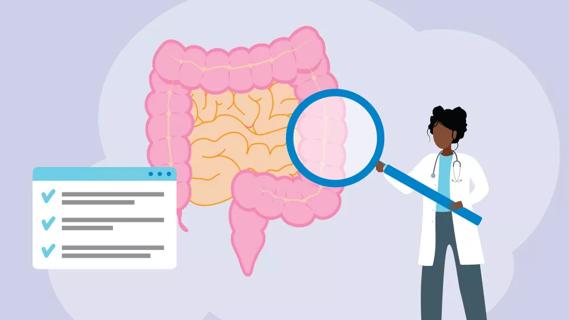Colonoscopy is most common, but there are other options, too

Colorectal cancer can be deadly — but data shows that early screenings are saving lives by detecting colon cancer earlier than ever before. And although a colonoscopy is the gold standard in cancer screenings, it’s not the only method to detect this disease.
Advertisement
Cleveland Clinic is a non-profit academic medical center. Advertising on our site helps support our mission. We do not endorse non-Cleveland Clinic products or services. Policy
Your colon is a key part of your digestive system. Colon cancer usually begins as a noncancerous growth called a polyp, which grows on the inner lining of your colon. These polyps develop over time — typically anywhere from 10 to 20 years.
Gastroenterologist Brenda Jimenez Cantisano, MD, discusses options for colorectal cancer screenings, from the traditional colonoscopy and beyond, and how to know which is best for you.
Because colon cancer tends to grow slowly, you may not experience any symptoms of the disease — which is why it’s so important to have regular screenings to catch problems before they arise.
Your risk of colorectal cancer increases as you age, and current guidelines say you should start being screened at age 45. If you have a family history of colon and rectal cancers, though, talk to your doctor about getting screened earlier.
In recent years, cases of colorectal cancer have increased significantly in younger adults ages 20 to 49. It’s vital that you see your doctor if you start experiencing any warning signs of this cancer before you’ve ever been screened.
“Early colorectal cancer has no symptoms, but when it starts to become more advanced, there are certain things you shouldn’t ignore,” Dr. Jimenez Cantisano says. You should talk to your doctor if you have:
Advertisement
The most common screening evaluation is a colonoscopy, a short procedure to examine your large bowel. But there are other ways, too, including blood tests, DNA stool tests and more.
Each has their pros and cons, including overall effectiveness, amount of prep work and time required. Dr. Jimenez Cantisano explains them.
Of the colorectal cancer screening options, colonoscopy has the highest ability to detect colon cancer and polyps, up to 70%.
This test allows your doctor to see inside of your large intestine using a flexible camera called a scope. This procedure may or may not require sedation, such as conscious sedation (“twilight”) or general anesthesia. A colonoscopy checks for symptoms like bleeding, as well as polyps and other possible signs of cancer. Importantly, during a colonoscopy, your doctor can both detect and remove a polyp.
“A colonoscopy has the benefit of being a one-step test, whereas other tests, like stool-based testing, may require two steps,” Dr. Jimenez Cantisano notes. “If a stool-based test has a positive result, a colonoscopy will be indicated for further evaluation.”
Before a colonoscopy, your bowels must be completely empty, so there’s some pre-procedure prep work involved — and although it can be unpleasant, it’s key to the procedure being successful.
“If there is stool covering or coating the colon, the endoscopist will not be able to fully visualize the colon and some polyps may be missed,” Dr. Jimenez Cantisano explains.
This type of procedure, also known as a virtual colonoscopy, also requires you to empty your bowels ahead of time, but you don’t have to be sedated during the procedure itself. If your virtual colonoscopy detects a polyp, your doctor will recommend a standard colonoscopy.
A colonoscopy itself can’t tell the difference between non-precancerous and precancerous polyps. For this, you’ll need a biopsy (tissue sample), which can be done during the process of a regular colonoscopy but not during a virtual colonoscopy. (This is why you’ll need to follow up with a colonoscopy.)
Similar to a colonoscopy, a flexible sigmoidoscopy is an outpatient procedure performed in a medical setting. It also requires prep work to empty your bowels.
But the flexible sigmoidoscopy only evaluates the left side of your colon. It can be used to evaluate conditions like ulcerative colitis, and can detect polyps — but only on your left side.
Advertisement
“If you have a precancerous growth on the left side, a second test, like a colonoscopy, is recommended,” Dr. Jimenez Cantisano says, “so it is not often performed as a screening for colorectal cancer.”
There are a few common types of stool-based tests:
“The benefit of these tests is that you can do them at home,” Dr. Jimenez Cantisano says. “You do not need to do special preparation or a diet in advance of them, and they can be done at home, with no time taken off work to complete them.”
Again, though, if these tests come back positive, a colonoscopy will be recommended.
Before scheduling any screening tests, speak with your primary care doctor, who’ll go through the options with you.
To learn about your specific risk factors, they’ll ask about your family health history and your own history, including age, race, current health conditions, lifestyle habits and more. This information will help determine which test is right for you.
Advertisement
“The best screening test, though, is the test that gets done, period,” Dr. Jimenez Cantisano stresses, “so speak with your physician, and make sure you get screened at an appropriate time.”
Advertisement
Learn more about our editorial process.
Advertisement

Focus on exercise, eating healthy and getting regular screenings to help lower your risk

Chronic inflammation from flare-ups can damage the lining of your intestinal wall, making your colon more vulnerable to cancer

Colonoscopies and sigmoidoscopies are types of endoscopies, procedures that look at the health of your large intestine

A steady increase in cases in those younger than 50 started decades ago

If you’re at average risk, it’s recommended that you get your first colonoscopy at age 45

It’s a slow-moving process that offers an opportunity for early detection and treatment

At-home screening options can be good detection tools, but a colonoscopy remains the gold standard

Knowing your family history and getting a genetic test can help detect colorectal cancer earlier

If you’re feeling short of breath, sleep can be tough — propping yourself up or sleeping on your side may help

If you fear the unknown or find yourself needing reassurance often, you may identify with this attachment style

If you’re looking to boost your gut health, it’s better to get fiber from whole foods